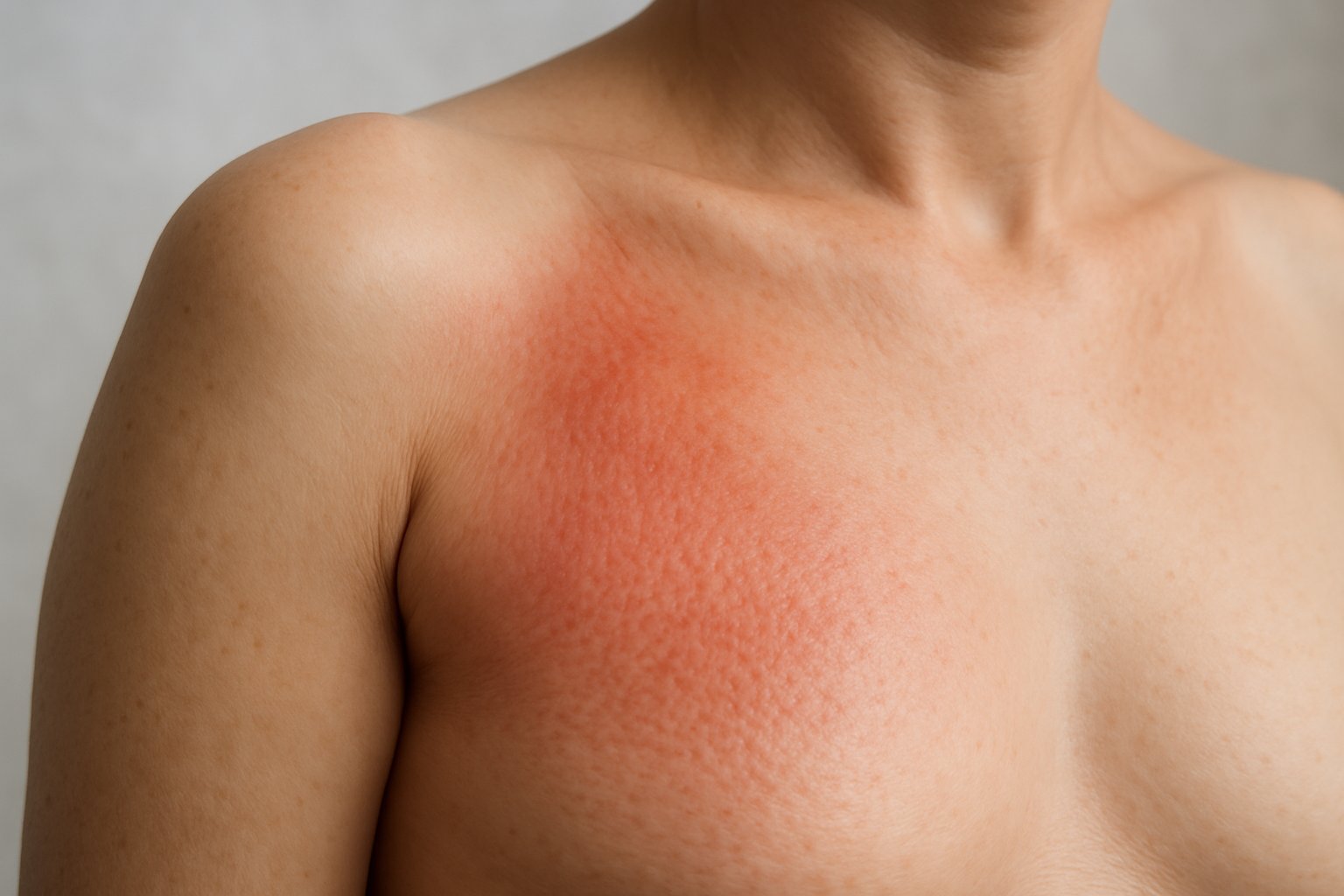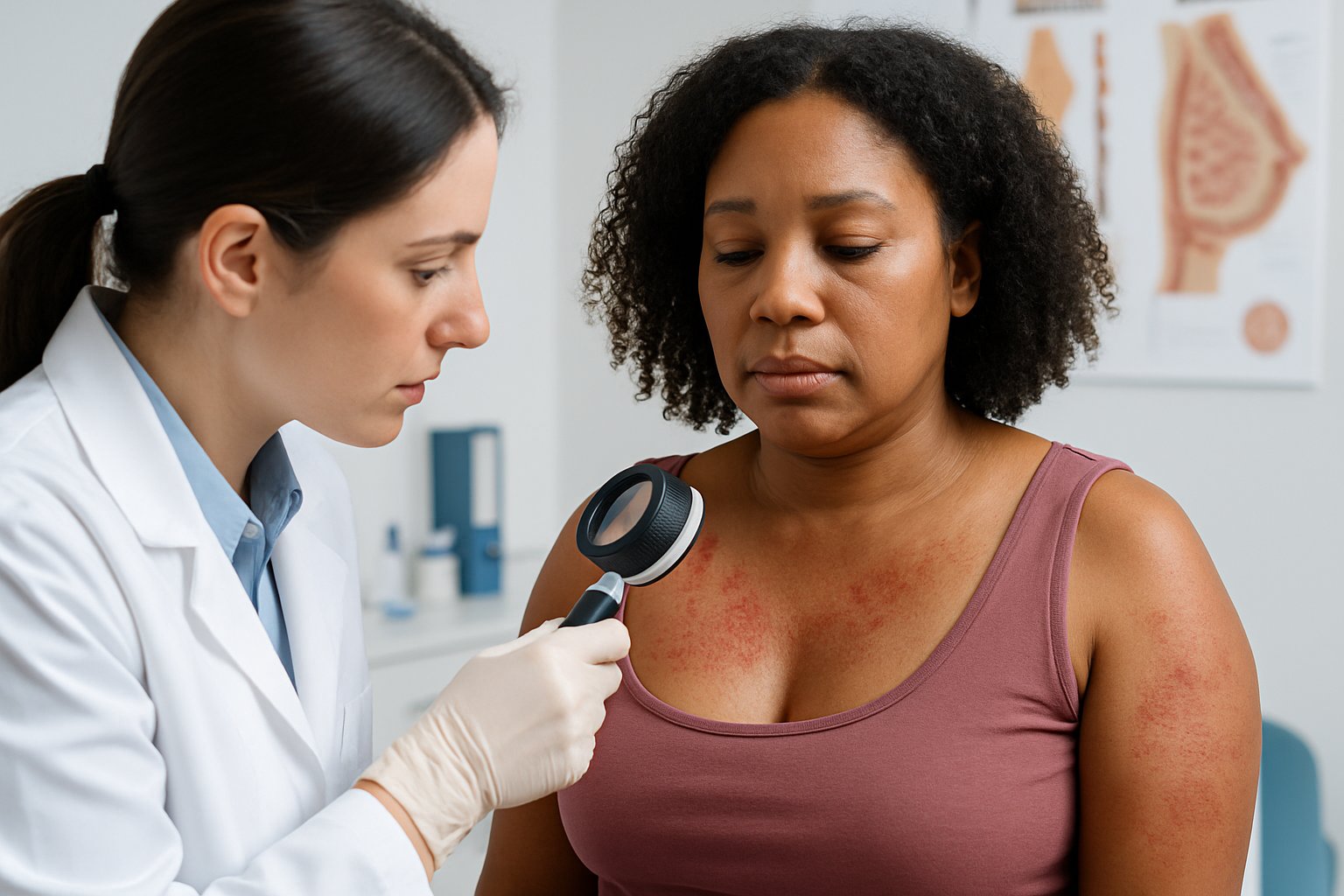TNBC skin symptoms include redness, dimpling, orange peel texture, and visible swelling that require immediate medical evaluation. These skin changes are often overlooked but serve as important early warning signs of aggressive breast cancer. Prompt recognition and clinical assessment of skin symptoms can lead to faster diagnosis and treatment outcomes.
Triple-negative breast cancer affects the skin in distinct ways that patients and healthcare providers should recognize early. This aggressive form of breast cancer lacks three key receptors that fuel most breast cancers, making it more challenging to treat and potentially causing unique skin-related symptoms.

The most common skin symptoms of TNBC include redness, dimpling, thickening of the skin, “orange peel” texture, visible swelling, and changes in breast size or shape. These skin symptoms can range from rashes to complex changes in skin texture[1] and are often overlooked during initial assessments. The skin changes occur because cancer cells can block lymph vessels and affect the surrounding tissue structure.
Understanding these warning signs helps patients seek medical attention promptly. Any unusual changes in breast skin should be evaluated by a healthcare provider[2] since early detection remains crucial for this aggressive cancer type. Recognizing skin symptoms alongside other breast changes can lead to faster diagnosis and treatment.
Key Symptoms of TNBC Skin
Triple-negative breast cancer can cause several distinct skin changes that affect the breast area. These symptoms include visible discoloration, unusual texture changes, swelling, and nipple-related changes that require immediate medical attention.
Redness and Discoloration
TNBC skin symptoms commonly include redness[2] that appears across the breast surface. This redness may develop gradually or appear suddenly.
The affected skin often looks inflamed or irritated. The discoloration can range from light pink to deep red.
Some patients notice the redness spreads beyond the immediate tumor area. The skin may feel warm to the touch in these discolored regions.
Warning signs include:
- Persistent redness that doesn’t fade
- Skin that appears sunburned without sun exposure
- Red patches that grow larger over time
- Discoloration combined with other skin changes
The redness often appears different from typical skin irritation or rashes. It tends to be more persistent and doesn’t respond to typical skin treatments.
Texture Changes and Peau d’Orange
Skin thickening and “orange peel” texture[2] are hallmark signs of TNBC skin involvement. This condition is called peau d’orange.
The skin develops a dimpled appearance similar to an orange peel. The texture becomes rough and bumpy rather than smooth.
Dimpling and puckering of the skin[3] may occur in specific areas. These changes happen because cancer cells block lymphatic vessels.
Common texture changes:
- Thick, leathery skin feel
- Visible pores that look enlarged
- Dimpled or pitted surface
- Loss of skin elasticity
The affected area may feel different when touched. Normal skin flexibility disappears in these regions.
Swelling or Inflammation
Visible swelling[2] affects the breast tissue and surrounding skin areas. This swelling can cause noticeable size differences between breasts.
The inflammation may cause the breast to feel heavy or uncomfortable. Swelling typically doesn’t improve with rest or elevation.
Changes in breast size or shape[3] often accompany the skin changes. One breast may appear larger or have an altered contour.
The swelling can extend to nearby areas including the chest wall. Some patients notice swelling in the underarm region as well.
Key swelling indicators:
- Sudden breast enlargement
- Asymmetry between breasts
- Skin that appears stretched or tight
- Persistent puffiness
Nipple Changes and Discharge
Nipple retraction or inversion[3] can occur as TNBC progresses. The nipple may turn inward or appear flattened.
Bloody or fluid discharge from the nipple[3] requires immediate medical evaluation. This discharge may be clear, yellow, or contain blood.
The skin around the nipple may become scaly or crusty. These changes can resemble eczema but don’t respond to typical treatments.
Some patients notice changes in nipple sensitivity or sensation. The nipple area may become more tender or lose feeling entirely.
Critical nipple symptoms:
- Any new discharge
- Nipple pulling inward
- Scaling or crusting around the areola
- Changes in nipple position or shape
Detection and Clinical Assessment of TNBC Skin Symptoms

Doctors use multiple methods to detect and assess TNBC skin symptoms, including physical exams, imaging tests, and laboratory analysis. The process involves checking for visible skin changes, using specialized scans to see inside breast tissue, and testing cancer cells to confirm the absence of key receptors.
Physical Examination and Self-Checks
Healthcare providers perform thorough physical exams to identify TNBC-related skin changes. They look for specific signs that may indicate inflammatory breast cancer symptoms[4].
Key examination areas include:
- Breast skin texture and color changes
- Swollen lymph nodes under the arm or collarbone
- Nipple appearance and discharge
- Overall breast size and shape differences
Doctors check for peau d’orange, which makes skin look like an orange peel. This dimpled appearance happens when cancer cells block lymph vessels in the skin.
Self-checks help patients notice changes early. Women should look for redness, swelling, or skin that feels warm to touch. Any breast skin covering at least one-third of the breast that appears pink, purple, or bruised needs medical attention.
Monthly self-exams work best when done at the same time each month. Patients should report any new skin changes to their doctor right away.
Role of Mammograms and Ultrasound
Imaging tests help doctors see changes inside breast tissue that physical exams might miss. Mammograms use X-rays to create detailed pictures of breast tissue and can show abnormal areas.
Ultrasound uses sound waves to create images of breast tissue. This test works well for looking at dense breast tissue and can help guide needle biopsies.
Breast MRI provides the most detailed images using magnetic fields. Doctors often use MRI when other tests show unclear results or when checking if cancer has spread.
These imaging tests cannot tell if cancer is TNBC. They show suspicious areas that need further testing. The National Cancer Institute recommends combining imaging with physical exams for accurate breast cancer diagnosis.
Inflammatory TNBC may not always show up clearly on mammograms. Ultrasound often works better for seeing skin thickening and tissue changes under inflamed breast skin.
Receptor Testing and Biopsy
A biopsy removes small tissue samples for laboratory testing. This step confirms the breast cancer diagnosis and determines if the cancer is TNBC.
Laboratory tests check for three specific receptors:
- Estrogen receptor
- Progesterone receptor
- HER2 protein
TNBC tests negative for all three receptors. This absence of receptors makes TNBC different from other breast cancers and affects treatment options.
Oncologist specialists review biopsy results to plan treatment. The testing process usually takes several days to complete.
Core needle biopsy is the most common method. Doctors use imaging guidance to target suspicious tissue areas. This procedure provides enough tissue for complete receptor testing.
Genetic testing may also be recommended. Many TNBC patients carry BRCA1 gene mutations that increase cancer risk.
Frequently Asked Questions
TNBC can cause distinct skin changes that appear on or around the breast area. These symptoms range from color changes and texture problems to swelling and shape differences.
What are the common signs that might indicate Triple Negative Breast Cancer has affected the skin?
Common skin symptoms of TNBC include redness, dimpling, thickening of the skin[2]. The skin may develop an “orange peel” texture called peau d’orange.
Visible swelling often occurs along with changes in breast size or shape. The affected area may feel heavy or different than usual.
Purple discoloration over the chest area[5] can also appear. Any unusual changes in breast skin texture or appearance need medical evaluation.
How can skin changes signal the presence of Triple Negative Breast Cancer?
Skin changes often appear when cancer cells block lymph vessels or spread to skin tissue. This blockage causes fluid buildup and inflammation.
Dimpling or puckering of the skin resembling an orange peel’s surface[5] happens when cancer pulls on surrounding tissue. The skin loses its smooth appearance and develops an uneven texture.
Redness and warmth may occur as the body’s immune system responds to cancer cells. These changes typically appear gradually over weeks or months.
What symptoms suggest metastasis of Triple Negative Breast Cancer to the skin?
Skin metastasis often appears as firm nodules or lumps under the skin surface. These growths may be pink, red, or purple in color.
The affected skin area may become thick and leathery. Small bumps or raised areas can develop across the chest or breast region.
Ulceration or open sores may form in advanced cases. The skin around these areas often becomes painful or tender to touch.
Are there specific skin-related symptoms that distinguish Triple Negative Breast Cancer from other breast cancer types?
TNBC tends to grow more quickly than other breast cancer types. This rapid growth can cause more dramatic skin changes in a shorter time period.
The inflammatory appearance is often more pronounced with TNBC. Redness and swelling may be more intense compared to other breast cancer forms.
Skin symptoms associated with TNBC can vary widely[1] between patients. However, the speed of symptom development often sets TNBC apart from slower-growing cancers.
What are the early warning skin symptoms that could point toward Triple Negative Breast Cancer?
Early skin changes may be subtle and easy to miss. Small areas of redness or slight skin thickening can be the first signs.
Minor dimpling that appears when raising the arms may indicate early tissue changes. The breast outline or shape might look slightly different than before.
Skin that feels warmer than usual in one area can signal developing problems. Any persistent skin changes lasting more than two weeks need medical attention.
How might skin texture or appearance change as a result of Triple Negative Breast Cancer?
The skin surface often becomes rough or bumpy instead of smooth. This texture change happens as cancer affects the underlying tissue structure.
Skin may appear shiny or tight due to swelling beneath the surface. The normal skin folds and creases can become less visible.
Color changes range from pink to deep red or purple shades. The affected skin may look different from the surrounding healthy tissue in both color and texture.
References
- Exploring Cutaneous Symptoms in TNBC: Insights from Recent Research. https://innovareacademics.in/blog/exploring-cutaneous-symptoms-in-tnbc-insights-from-recent-research/ Accessed October 25, 2025
- What is TNBC of the Skin: Symptoms and Treatment. https://www.getlabtest.com/news/post/what-is-tnbc-skin-symptoms-treatment Accessed October 25, 2025
- Triple-Negative Breast Cancer (TNBC): Causes, Symptoms, and Treatments. https://www.upmc.com/services/breast/conditions/triple-negative-breast-cancer Accessed October 25, 2025
- Attention Required!. https://www.cityofhope.org/clinical-program/breast-cancer/types/triple-negative-breast-cancer Accessed October 25, 2025
- Inside Tnbc Skin. https://www.withpower.com/guides/inside-tnbc-skin Accessed October 25, 2025
